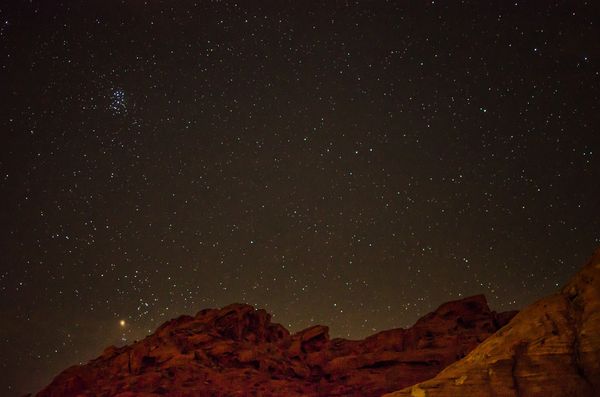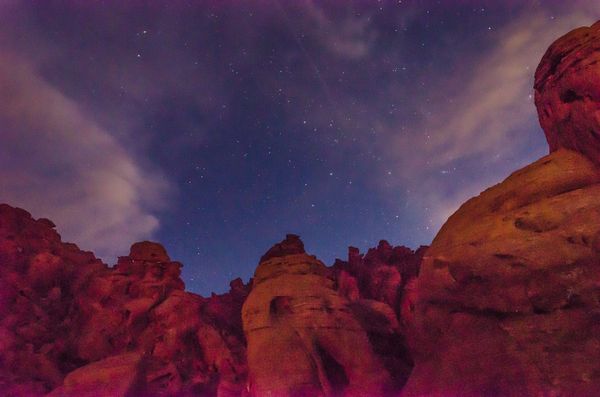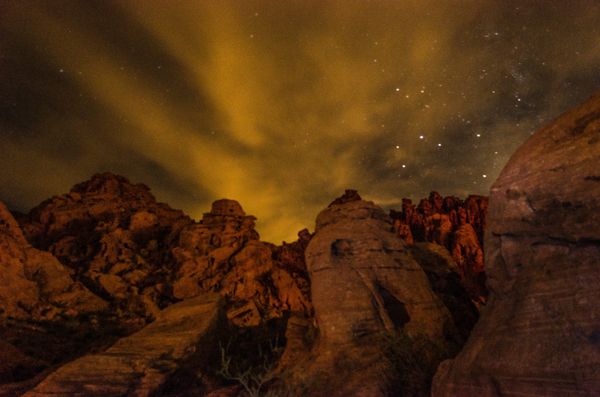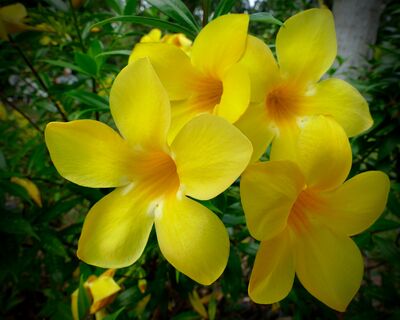Newby Night Shots
Oct 13, 2015 22:36:44 #
I am starting to get into night photography. Here are a couple of shots from a few nights ago in Valley of Fire State Park near Las Vegas.
I would like thoughts or comments and am open to criticism on how to make them better.
I would like thoughts or comments and am open to criticism on how to make them better.
Nikon 5100, 35mm Fixed lens, f1.8, 4.0 secs, ISO 800

Nikon 5100, 18-55mm kit lens @ 18mm, f8.0, 15.0 secs, ISO 1600

Nikon 5100, 18-55mm kit lens @ 18mm, f4.5, 30.0 secs, ISO 200

Oct 13, 2015 23:03:56 #
I like them all. I'm a newbie too, so would be very interested in the comments from our experienced members.
Oct 14, 2015 00:38:18 #
rbartz wrote:
I am starting to get into night photography. Here are a couple of shots from a few nights ago in Valley of Fire State Park near Las Vegas.
I would like thoughts or comments and am open to criticism on how to make them better.
Richard
I would like thoughts or comments and am open to criticism on how to make them better.
Richard
Very nice. You are off to a very good start. You have picked good settings and you can see how the camera can see quite well in the dark.
The important things for astrophotography are basically:
1) A Really Good Lens -- So, so glass will really show why it is so, so glass. You want stars to remain as points and not show distortion. Coma Distortion, that you would never see in a terrestrial image, is really obvious when imaging stars. The faster the lens, the better, provided it does not distort when wide open. The F1.8 and F2.8 lenses are preferable over slower lenses. A cheaper zoom that offers a variable F3.5 to F5.6 for example is probably not a good choice.
2) A Really Good Focus -- This is really, really important. You have to make the focus perfect. Close is not good enough. Stars grow fat and dimmer if focus is just a tiny bit off. It is far more critical than terrestrial focusing.
3) A Dark Sky
4) Good Post Processing
5) Either very low noise, or a way to remove that noise after the image has been taken.
As you gain more experience, a tracking device for the camera can produce images that are not otherwise possible. I have used the iOptron SkyTracker for 4 minutes at 24mm. And 1 minute at 200mm.
Oct 14, 2015 08:43:16 #
hettmoe
Loc: Rural ND
I really like your photos, Richard. Just keep getting out there and enjoy yourself. The people on this site will give you plenty of info. You have stopped by the right place.😀
Oct 14, 2015 13:33:25 #
Welcome to the Astrophotography section!
Great Start, Richard.
I figure I'm new at this too.
I've only gotten really serious since last April or so when I jumped with abandon and ordered my wish list.
In August, I discovered time-lapse of the skies. Now I go and set my camera and tripod and let the Intervalometer march the camera along.
This morning I gathered up my treasure and found close to 3000 exposures to play with. :shock: (OK, 2,777, but who's counting... ;) )
Enough about that. :roll:
You done good to title in your settings and lenses. Next time, Please check the little box to the right that sez store original.
That way we can download and examine your photo for you much better, including checking the EXIF data of the frame.
Off hand, I would suggest more sky, less Terra Firma.
They call it The Rule of Thirds. Roughly, 1/3 of something (ground), and 2/3rds of your other composition (stars).
Another way to compose is just enough Terra to show reference, and the rest sky.
1/2-1/2 is fine, but it can leave the eye, or my cocked eye anyway, wondering if the rocks were the subject, or the stars.
So I'm suggesting more stars, if stars are your aim.
I would like to offer a single random sample, (From my phone camera) the sky was my aim to capture the sunrise. Centered bottom is my "real" camera on my tripod capturing time-lapsed shots.
http://www.dropbox.com/sc/iatxjne1e4iqflv/AAAjvPlT6cg2AvCiB-u3rVJZa (Sometimes this link is slow for me. ???)
See how the subject, the sky, is the most predominant thing before the viewers eye. ;)
So caution, you are standing on the edge of a very slippery slope.
You can slide right into Astrophotography from here. My demise began when I laid in a lawn chair, in insulated Carrhart coveralls, tripping my cameras shutter with a hand held release on a cold California evening.
And I succumbed to the wonders of the Universe.
As it has been said, it is the most rewarding, yet frustrating type of photography you can undertake.
The "guy" that dragged me into this has returned. My favorite constellation Orion the Hunter.
And why I had my camera shooting 4 frames a minute, for nearly 12 hours overnight. To gather the 2,600-ish frames for todays gleefilled project. (And changing camera batteries @ 2 AM.)
Orion was quickly slipping South in the early spring when I spotted the Nebula through a 60X spotting scope.
This cycle, I'm armed to the teeth and been practicing.
You, and Cathy too, have come to a really great place to begin Astrophotography. There are many die hard Astronomers here who pursue the same thing. And they are incredibly friendly and immensely helpful.
Please shoot and post away. Be patient while the Big Guns find and comment to help you along.
Lastly, I find the delete key, and Format in my camera, forgives all sins.
If, perchance, you are interested, I would share where I am depositing my feeble attempts at time lapsed Astrophotography.
Sonny Edmonds on YouTube. (I suggest any choice be viewed full screen and speakers on.)
Great Start, Richard.
I figure I'm new at this too.
I've only gotten really serious since last April or so when I jumped with abandon and ordered my wish list.
In August, I discovered time-lapse of the skies. Now I go and set my camera and tripod and let the Intervalometer march the camera along.
This morning I gathered up my treasure and found close to 3000 exposures to play with. :shock: (OK, 2,777, but who's counting... ;) )
Enough about that. :roll:
You done good to title in your settings and lenses. Next time, Please check the little box to the right that sez store original.
That way we can download and examine your photo for you much better, including checking the EXIF data of the frame.
Off hand, I would suggest more sky, less Terra Firma.
They call it The Rule of Thirds. Roughly, 1/3 of something (ground), and 2/3rds of your other composition (stars).
Another way to compose is just enough Terra to show reference, and the rest sky.
1/2-1/2 is fine, but it can leave the eye, or my cocked eye anyway, wondering if the rocks were the subject, or the stars.
So I'm suggesting more stars, if stars are your aim.
I would like to offer a single random sample, (From my phone camera) the sky was my aim to capture the sunrise. Centered bottom is my "real" camera on my tripod capturing time-lapsed shots.
http://www.dropbox.com/sc/iatxjne1e4iqflv/AAAjvPlT6cg2AvCiB-u3rVJZa (Sometimes this link is slow for me. ???)
See how the subject, the sky, is the most predominant thing before the viewers eye. ;)
So caution, you are standing on the edge of a very slippery slope.
You can slide right into Astrophotography from here. My demise began when I laid in a lawn chair, in insulated Carrhart coveralls, tripping my cameras shutter with a hand held release on a cold California evening.
And I succumbed to the wonders of the Universe.
As it has been said, it is the most rewarding, yet frustrating type of photography you can undertake.
The "guy" that dragged me into this has returned. My favorite constellation Orion the Hunter.
And why I had my camera shooting 4 frames a minute, for nearly 12 hours overnight. To gather the 2,600-ish frames for todays gleefilled project. (And changing camera batteries @ 2 AM.)
Orion was quickly slipping South in the early spring when I spotted the Nebula through a 60X spotting scope.
This cycle, I'm armed to the teeth and been practicing.
You, and Cathy too, have come to a really great place to begin Astrophotography. There are many die hard Astronomers here who pursue the same thing. And they are incredibly friendly and immensely helpful.
Please shoot and post away. Be patient while the Big Guns find and comment to help you along.
Lastly, I find the delete key, and Format in my camera, forgives all sins.
If, perchance, you are interested, I would share where I am depositing my feeble attempts at time lapsed Astrophotography.
Sonny Edmonds on YouTube. (I suggest any choice be viewed full screen and speakers on.)
Oct 14, 2015 15:36:16 #
JimH123 wrote:
Very nice. You are off to a very good start. You... (show quote)
Welcome to the Astrophotography Forum. Very nice start, much better than I did to begin with. I think Jim H pretty much summed it all up.
He did hint to the fact that without a tracking mount the higher the zoom the faster the shutter speed to preserve those round stars.
Craig
Oct 14, 2015 16:45:23 #
CathyAnn wrote:
I like them all. I'm a newbie too, so would be very interested in the comments from our experienced members.
Hi Cathy Ann!
Welcome to the Astrophotography forum!
Grab your tripod, grab a lawn chair that lays back, and shoot some Stars!
Oct 14, 2015 17:53:45 #
SonnyE wrote:
Hi Cathy Ann!
Welcome to the Astrophotography forum!
Grab your tripod, grab a lawn chair that lays back, and shoot some Stars!
Welcome to the Astrophotography forum!
Grab your tripod, grab a lawn chair that lays back, and shoot some Stars!
Thank you, SonnyE! :-P
Oct 14, 2015 19:38:50 #
Oct 14, 2015 21:19:18 #
JimH123 wrote:
Very nice. You are off to a very good start. You have picked good settings and you can see how the camera can see quite well in the dark.
The important things for astrophotography are basically:
2) A Really Good Focus -- This is really, really important. You have to make the focus perfect. Close is not good enough. Stars grow fat and dimmer if focus is just a tiny bit off. It is far more critical than terrestrial focusing.
.
The important things for astrophotography are basically:
2) A Really Good Focus -- This is really, really important. You have to make the focus perfect. Close is not good enough. Stars grow fat and dimmer if focus is just a tiny bit off. It is far more critical than terrestrial focusing.
.
Did some snipping as focus is all I want to ask about. With all the lenses I have ever had the focus ring stops at the infinity mark. Stars will be millions, billions, and more light years away, but technically that is less than infinity. Next taking my Sony a6000 as an example: the largest image is 6000 by 4000 for 24 Mp on a sensor of 24.3 Mp effective, the EVF is 1.44 Mp, the LCD is 0.9216 Mp. So in the EVF I can see only 1 of every 16 pixels. In the LCD it is 1 in 26. So what looks sharp in either of those camera views might be way off in the actual image. So how can one actually do a focus.
Oct 14, 2015 21:54:54 #
John_F wrote:
Did some snipping as focus is all I want to ask ab... (show quote)
Have you used the Focus Magnifier with the Sony A6000. This allows you to magnify the star so that you can see better what you are doing. Need a solid tripod setup that does not wiggle. Then you start Focus Magnifier. It creates a box in the center of the screen. You can move it around with the arrows. Pick a star you want to use. Hit the enter button. That box now fills the screen. Focus the best you can. To get more magnification, hit enter again and it is even bigger. Carefully continue for focusing.
As you get to critical focus, dimmer stars will come into view. You will notice that these are even more finicky and disappear from view altogether as you move out of focus even the slightest amount. At this point, I forget the brighter star and use that dim star and adjust for it to be its brightest. At this point, you are set and can take a picture.
From time to time, recheck this focus. A very tiny bump can change it.
Now some lenses just won't let you reach infinity. They stop just short. I have some of those and I can't use thm for this. But I have several others that don't have this problem and work beautifully. Several of my favorites are the Tamron 24-70 f2.8 and Tamron 70-200 f2.8. I have an older Minolta 100mm f2.8 macro lens and it works good too.
I also have some lenses that the stars distort near the edges and corners. I would have to stop down to get away from this problem, but stopping down is not what I what to do. I want max light.
So the bottom line here is that you have to find out which lenses can do it and use them. Correctly focused stars are one of the best lens tests I know of. If the lens doesn't stack up good enough, it won't produce pin point stars. It may even look perfectly good with other subjects. But stars are the real test.
I am finding that my Sony A77ii and Sony A99 are surpassing the Sony A6000 when it comes to low noise. I am a stickler for low noise. On any given night, the same ISO setting might not be useable that I used on another night. So I take test shots and decide what I am going to use on any given night. And what part of the sky I am shooting has a big effect on this too. When you shoot into the crowded portion of the Milky Way, the tons of stars tend to make noise seem worse for example. I will then pick an ISO that gives me what I am looking for.
Good luck!
Oct 15, 2015 00:27:30 #
My Nikon D5100 has "Live View" with magnification for focusing which helps me a lot. I have not had the opportunity just yet to have a REALLY dark sky, so I had to focus on brighter stuff.
I did find it is a lot easier to get sharp images with the 35MM fixed lens than with either of my Nikon zooms or my Tamron Zoom.
I don't like noise either and again, the fixed lens excels because I can stop down to 1.8 and keep the ISO way down. However, I found that even 10 seconds with that 35mm (DX so ~50) lens gives me trails. Does that sound right according to the 600 rule thing?
Richard
I did find it is a lot easier to get sharp images with the 35MM fixed lens than with either of my Nikon zooms or my Tamron Zoom.
I don't like noise either and again, the fixed lens excels because I can stop down to 1.8 and keep the ISO way down. However, I found that even 10 seconds with that 35mm (DX so ~50) lens gives me trails. Does that sound right according to the 600 rule thing?
Richard
Oct 15, 2015 00:45:28 #
rbartz wrote:
My Nikon D5100 has "Live View" with magn... (show quote)
Yes, you will see star trails at 10 sec with that focal length. I really don't pay much attention to the rule. I just take a couple test shots and I know what I can then do.
You didn't say what zooms you are using, but the slower zooms, such as F3.5 to F6.3 for example tend to be very hard to see the stars to even focus. Faster lenses are definitely better.
Oct 15, 2015 02:38:14 #
As Jim said, focus is really hard to acquire.
It is a bane of mine. I think my eyes are getting too old, time to trade them in. :lol:
My DSLR lenses seem to easily swing from one side of great, to the other side of great. Hitting that wow sharp is a pain.
And with stars, even with the live view zoomed in, it's very elusive.
With my telescope, I will often let the deep space camera "loop" while I adjust watching my image on the laptop screen. And do my extremely fine adjustments trying to get my sharpest focus that way.
But there is a lesson in running Astrophotography through a telescope, everything affects the focus. Even temperature changes.
So I just try and do the best I can.
You should, too.
There is no magic fix.
It is a bane of mine. I think my eyes are getting too old, time to trade them in. :lol:
My DSLR lenses seem to easily swing from one side of great, to the other side of great. Hitting that wow sharp is a pain.
And with stars, even with the live view zoomed in, it's very elusive.
With my telescope, I will often let the deep space camera "loop" while I adjust watching my image on the laptop screen. And do my extremely fine adjustments trying to get my sharpest focus that way.
But there is a lesson in running Astrophotography through a telescope, everything affects the focus. Even temperature changes.
So I just try and do the best I can.
You should, too.
There is no magic fix.
Oct 15, 2015 11:12:03 #
Great capture of Pleiades in your first image. Sonny is kind of right, there is no magical fix, there is but it is very pricey. Robotic focusing is a dream but when your focuser cost 10 times the amount of your telescope its a real head scratcher.
Matthew
Matthew
If you want to reply, then register here. Registration is free and your account is created instantly, so you can post right away.





